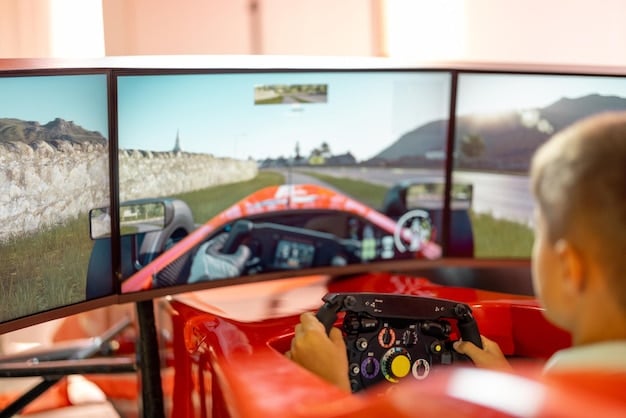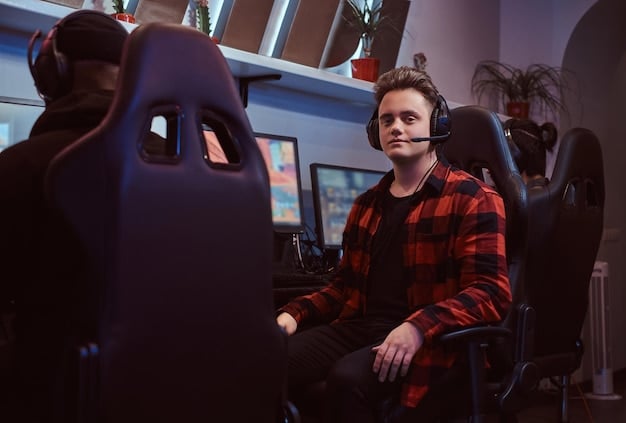Video Games & Car Culture: How Simulators Inspire Real-World Car Enthusiasts

The impact of video games on car culture is significant, influencing design, customization, and the very passion for automobiles through realistic simulators and engaging racing games that blur the line between virtual and real-world automotive experiences.
The automotive world has been revving its engines to the rhythm of a new player: video games. From hyper-realistic simulators to adrenaline-pumping arcade racers, the impact of video games on car culture: from simulators to real-world inspiration is undeniable, shaping how enthusiasts experience, customize, and even design their dream cars.
The Evolution of Car Simulators
Car simulators have evolved from simple arcade games to sophisticated tools that mimic the intricacies of real-world driving. This evolution has significantly impacted car culture, bridging the gap between virtual experiences and physical automotive enthusiasm.
Early Days of Racing Games
Early racing games like “Pole Position” and “Out Run” were simple but groundbreaking, introducing players to the thrill of racing and different car models.
Rise of Realistic Simulators
Games like “Gran Turismo” and “Forza Motorsport” raised the bar with realistic physics, detailed car models, and accurate recreations of real-world tracks. These games allowed enthusiasts to experience the nuances of driving different cars in a virtual setting.
- Detailed Car Models: Simulators feature meticulously crafted virtual representations of real cars, capturing every detail from the exterior design to the interior components.
- Realistic Physics: Advanced physics engines simulate the handling characteristics of different cars, accounting for factors like weight, aerodynamics, and tire grip.
- Accurate Track Recreations: Simulators recreate real-world racetracks with stunning accuracy, providing players with a virtual environment to test their driving skills.
- Customization Options: Many simulators offer extensive customization options, allowing players to modify their cars’ performance and appearance.
The evolution of car simulators has not only heightened the interest in car culture but has also provided a platform for aspiring racers and enthusiasts to hone their skills. This has led to a deeper appreciation of the mechanics and dynamics of automobiles.

The Influence of Video Games on Car Design and Customization
Video games have had a profound influence on how people design and customize cars. By offering players a virtual sandbox for automotive creativity, these games have spurred trends and provided inspiration for real-world modifications.
Virtual Customization Options
Games like “Need for Speed” series allow players to extensively customize their cars, from body kits and paint jobs to engine swaps and performance upgrades. This virtual customization often inspires real-world car enthusiasts to try similar modifications on their vehicles.
Inspiration for Real-World Mods
Many car enthusiasts draw inspiration from video game designs when modifying their own cars. Trends like wide body kits, neon lights, and custom paint schemes often originate in video games before making their way into real-world car culture.
The influence of video games on car design and customization extends beyond mere aesthetics. Games have also encouraged experimentation with different performance modifications, allowing enthusiasts to test the limits of their cars in a virtual environment and apply that knowledge to real-world builds. This has led to a new generation of car enthusiasts who are more informed and creative than ever before.
Esports and the Rising Popularity of Sim Racing
Esports have amplified the appeal of sim racing, turning it into a competitive arena that attracts both players and spectators. This has further integrated video games into the broader car culture landscape.
Professional Sim Racing Leagues
Professional sim racing leagues, such as the iRacing World Championship Series, offer high-stakes competition and attract talented drivers from around the world. These leagues have helped legitimize sim racing as a serious e-sport.
Increased Visibility and Sponsorships
With the growth of sim racing esports, sponsors have taken notice, investing in teams and drivers. This has increased the visibility of sim racing and brought it to a wider audience, connecting it more closely with real-world motorsport.
- High-Stakes Competitions: Professional sim racing leagues offer substantial prize pools and attract top-tier talent, creating a competitive environment that mirrors real-world motorsport.
- Global Audience: Sim racing events are streamed online, attracting a global audience of viewers who tune in to watch the action unfold.
- Sponsorship Opportunities: The increasing popularity of sim racing has attracted sponsors from various industries, including automotive, technology, and energy drinks.
- Real-World Integration: Some sim racers have transitioned to real-world motorsport, leveraging their virtual skills to compete in professional racing series.
The rise of sim racing as an e-sport has not only provided a platform for skilled drivers to showcase their talents but has also bridged the gap between virtual and real-world car culture. This integration has opened up new opportunities for drivers, teams, and sponsors, further solidifying the influence of video games on the automotive world.
Real-World Racing Drivers Training with Simulators
Many real-world racing drivers use simulators to train and improve their skills. Simulators offer a cost-effective and safe way to practice on different tracks and in various weather conditions, enhancing their performance on the real track.
Cost-Effective Training
Simulators are a fraction of the cost compared to real-world track time. Drivers can practice for hours without worrying about fuel costs, tire wear, or potential damage to their cars.
Safe Practice Environment
Simulators provide a safe environment for drivers to push their limits and experiment with different driving techniques. They can crash and make mistakes without any real-world consequences.
Real-world racing drivers use simulators to prepare for races, learn new tracks, and refine their driving skills. This has become an essential part of their training regime, contributing to their overall performance and competitiveness. The integration of simulators into professional racing has demonstrated the value of video games as a tool for honing skills and improving performance in the automotive world.

The Future of Car Culture: Blurring the Lines
The future of car culture is likely to see an even greater blurring of the lines between the virtual and real worlds. Advances in technology and the increasing popularity of video games will continue to shape how enthusiasts experience and interact with automobiles.
VR and AR Integration
Virtual reality (VR) and augmented reality (AR) technologies offer immersive ways to experience car culture. VR can transport users to realistic virtual environments, while AR can overlay digital information onto the real world, enhancing the driving experience.
AI-Driven Racing Games
Artificial intelligence (AI) is playing an increasing role in racing games, creating more challenging and realistic opponents. AI-driven games can adapt to the player’s skill level and provide a unique racing experience every time.
As technology continues to advance, the integration of video games and car culture will only deepen. Virtual reality and augmented reality will offer new ways to experience cars, while artificial intelligence will make racing games more realistic and engaging. This convergence of technology and passion will shape the future of car culture, creating exciting opportunities for enthusiasts to explore their love of automobiles.
The Social Aspect of Car Culture in Video Games
Video games have fostered a vibrant social aspect within car culture, connecting enthusiasts from around the globe. Online multiplayer modes and virtual car meets provide platforms for sharing knowledge, showcasing customized vehicles, and building communities centered around a shared love for cars.
Online Multiplayer Modes
Multiplayer modes in racing games allow players to compete against each other in real-time, fostering a sense of camaraderie and competition. These online battles provide a venue for testing skills and building friendships with fellow car enthusiasts.
Virtual Car Meets
Virtual car meets have become increasingly popular, providing a space for players to show off their customized vehicles and interact with like-minded individuals. These virtual gatherings serve as digital extensions of real-world car shows, fostering connections and celebrating automotive creativity.
The social aspect of car culture in video games has not only created vibrant online communities but has also transcended the virtual world. Many online friendships forged through racing games have led to real-world connections, with enthusiasts organizing meetups and events to share their passion for cars in person. This social dynamic has enriched car culture, making it more accessible and inclusive than ever before.
“`html
| Key Aspect | Brief Description |
|---|---|
| 🎮 Simulators | Provide realistic driving experiences, influencing car culture. |
| 🎨 Customization | Virtual options inspire real-world car modifications. |
| 🏆 Esports | Sim racing gains popularity and attracts real sponsorships. |
| 🧑✈️ Driver Training | Real drivers use simulators for cost-effective skill enhancement. |
“`
Frequently Asked Questions
▼
Modern car simulators are extremely realistic, featuring detailed car models, accurate track recreations, and advanced physics engines that mimic the handling characteristics of real cars. This allows enthusiasts to experience nuances.
▼
Video games provide extensive virtual customization options, inspiring real-world car enthusiasts to experiment with different designs and modifications. Trends like wide body kits and custom paint schemes often originate in video games.
▼
Esports have elevated sim racing by turning it into a competitive arena with professional leagues and high-stakes competitions. This has increased its visibility, attracting sponsors and connecting it with real-world motorsport.
▼
Yes, many real-world racing drivers use simulators for training. Simulators are cost-effective and safe to practice on different tracks, improve their skills, and prepare for races without real-world consequences.
▼
The future involves greater VR/AR integration for immersive experiences, AI-driven racing games for realistic opponents, and continued merging of virtual and real worlds, enhancing how enthusiasts interact with automobiles in car culture.
Conclusion
The influence of video games on car culture is undeniable, transforming how enthusiasts experience, customize, and interact with automobiles. From hyper-realistic simulators to esports and virtual car meets, the automotive world continues to evolve, driven by the innovations and passions fueled by video games.





